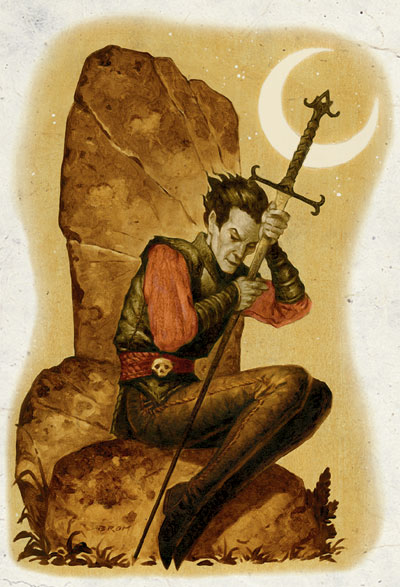Just because you use a fancier way of saying "adding" doesn't change what you are doing. Just because I chose to homebrew other races doesn't mean that I find halfling lore lacking more than the lore for other races.
These aren't arguments against my points. They are trying to tell me that I shouldn't have an issue with the existing lore, because I've changed other existing lore in the past. Perhaps you could try arguing something other than "if you add to the lore, you can fill in those gaps, and then those gaps never existed"
Well, if you've changed existing lore for one race, why do you have a problem doing it with another race?
1) "Lorekeeping" implies a rather formalized structure. As in, halflings would have people whose job it is, officially, to keep lore. They would have a name for such a person. For example, in Eberron the goblinoid people have the Duur'Kala, a position that is all about keeping the lore of their people. A Lorekeeper.
2) You see that bolded word? Unwittingly. This means that halflings have access to lore about ancient and long-gone cultures.... by accident. That means that they are not a traditional lore keeper race. They aren't going out and purposefully collecting lore for the purpose of preserving it. They are just... accidentally telling stories that happen to have those elements. Which cuts straight through the idea that their race is supposed to be a race of lorekeepers.
No it doesn't. It just means it's not necessarily a formal position--because unlike the Duur'Kala, almost every halfling knows the lore.
I asked if they were adventurers who were nomadic, or nomads, and you replied yes. So, you are saying all nomadic people are adventurers? So all Goliaths and orcs are adventures, because they are a heavily nomadic people.
I would say there is more to being an adventurer than being nomadic and traveling to different places.
Which is why the text also says that they're curious and like exploring.
So, traits #3, 5, 6, 7, 9, 13, 14, 15, 18, 19 and the lack of evil gods all read as... they are Good aligned. They have generic hero traits. I mean, seriously, some of these are just bland "I'm the good guy"-isms.
Many of those above-mentioned traits aren't inherently Good. Brave isn't Good. Villains can be affable and good-natured and then turn around and kill you, so that's not a Good trait. Disliking displays of wealth isn't Good. Being reliable and cooperative is Lawful, not Good.
And each of those words helps to paint a picture of what
kind of Good a halfling is.
They're also all different types of good. Elves are good, but they are famously
not open, welcoming, generous, and empathic to all, are usually described as capricious rather than reliable, and generally prefer the "pretty" people like artists and scholars to farmers.
You also repeated yourself, unless Brave is somehow different than being unflappably calm in the face of danger. Or being open and welcoming is different than being good-natured is different than being good hosts.
Uh, yes. Very different. One can be brave and also very emotional at the same time. And a person can be open and welcoming, a grump, and a terrible host. "Yeah yeah, come in. Go grab yourself a drink. Get me one too while you're at it. And take off your damn shoes."
That's a whole bunch of character traits, sure, but does it really tell you anything?
Yes, lots of things actually. I don't know why it doesn't tell you anything. This is why I think you're not actually bothering to think about the traits, or are allowing your dislike for halflings to blind you to them.
Except that halflings seem to be monolithic in personality traits. No other race has these universal personality traits of every member of the race being good, kind, helpful salt of the earth people? Isn't that a good thing?
Every single D&D race is monolithic. Every one of them. Elves are flighty, haughty, fey-like, magical. Dwarfs are stoic, gruff, heavy drinkers, bearded. Goblins are tricksy, cowardly, impulsive, destructive. Humans are innovative, curious, adaptable, ambitious. These are written as universal traits for those races. Why are you complaining about halflings and not these other races?
I specifically asked you what
you need to make a race interesting. Did you forget to answer?
I mean, reading this list, it is over and over again telling us how good, how pure, how good, and how uncorrupted and how good halflings are. They are just simple, kind folk with nothing more than their comforts of home. ALL OF THEM. I can see why people keep saying they make perfect adventurers, every single one of them is a YA fantasy protagonist.
So why is that bad? Does every member of every PC have to be edgy or grimdark or super-serious? Can't you have people who are just decent people?
And yes, I'm getting a little hyperbolic and frustrated, but it seems that listing personality and character traits and saying "all halflings are like this" is perfectly fine, but saying that I can play those characters without playing a halfling is me being a terrible and closeminded person.
No, you have been saying that
because you can play those characters without playing a halfling, that means that halflings are pointless and have no use or purpose in a setting. Those are very different things.
I can play a flighty, haughty, fey-like, and magical gnome, or a stoic, gruff, heavy-drinking, bearded orc, or a tricksy, cowardly, impulsive, and destructive tiefling. That doesn't mean elves, dwarfs, or goblins are pointless.
Earth Elementals are practically mindless, and have no opinions. Actually came up in our last game, that per the lore they are basically non-sapient beings. Also, you have no idea if Earth Elementals would find that upsetting or not. So, I'm not really going to engage in your "but I can make anything subjective" approach.
Earth elemental is also a term for any sort of elemental from the Plane of Earth. Which includes dao and a whole bunch of others, many of whom are not mindless.
I'd say if you read the stuff you cut you might have an idea. I'm not sure I'm up for repeating myself when you don't bother responding to what I write anyways.
I did. You didn't actually say why elves and dwarfs are important.
One of the things you said are "the point of elves is to have a magical and long lived race." But gnomes and firbolg are also magical and long-lived. Many other races are magical, and many other races are long-lived. And that's ignoring the tons of monsters that live for many hundreds or thousands of years or that are immortal.
And that's ignoring that there's a section in the PH description of humans that talks about how humans,
"dream of immortality, but (except for those few who seek undeath or divine ascension to escape death's clutches) they achieve it by ensuring that they will be remembered when they are gone" by building institutions. Meaning you can remove elves from a setting and lose nothing, because several other races have the same aspects covered.
Ditto for dwarfs. You say "But the idea of dwarves is to take that same enormous lifetime and apply it to crafting. Dwarves make the best and most enduring things" but again, there's other races that can do the same thing. Gnomes are amazing crafters. And if you aren't on Krynn, the stuff they make rarely explodes. And several monsters are good crafters as well, like fire giants and azer. If you take dwarfs out, all that happens is that you get stone objects that don't last
quite as long... and considering that we nonmagical humans in the real world have made structures that have
literally lasted for millennia. And we managed to not release any balrogs while doing so. (Sadly, many humans
do suffer from gold fever.)
In other words, neither elves nor dwarfs are so important that you really lose something by not including them. You just don't have them in the world. Something else will take their place. Or not, because sometimes, it's fine to not have a particular trope in a setting.
Now look at the list of the traits I wrote about for halflings. If you take out halflings, what do you lose: you lose kind people who can bridge the gaps between other races and help others get along. You lose people who make things that others find comfortable. You lose a steady source of food and ale and household goods. A dwarf can build you a nice stone house, and an elf can make you a magical, ever-changing painting, but the halfling would make the comfortable couch you can stretch out on and relax while eating a nice dinner. You lose a people who bring a sense of wonder to those around them. You lose a people who try to make the world a nicer place.
So then answer this question: why is
this bad or uninteresting? Yeah, it's not epic. There's very little blood involved. It's PG-rated. But in general? It's a good, useful, and
important role.
And yeah, you can take them out and not lose much, like you wouldn't lose much by taking out any other race. You can probably even take that same role and give it to another race, if you wanted to. But
that is not a good enough reason to not include them in the first place.
And there is no human pantheon. It doesn't really exist.

forgottenrealms.fandom.com
"Is it A or B"
"Yes"
Well, thanks for not answering any question or helping to clarify.
Yes, it's both. Duh.
VGR? Wait, Ravenloft?
Sure, a DM can make a homebrew decision, or use whatever brand new rules you want, but "we've been playing homebrew for years, and therefore all halflings are extra good against mundane fear because that's how our homebrew works" is... poor.
Yeah, so a very common homebrew rule, based on similar rules from earlier editions, is poor. Right...
Great, so they aren't scared of the unknown.
Are they scared of the known?
Not really.
An example: I like spiders. They have the cutest faces. They have adorable footsies. Or tarsi, whatever. They're awesome and amazing.
That's what halflings are like. Show them something that would frighten or creep other people out and they'll think it's pretty interesting, actually.
But that isn't what the ability does. They can freely move through the space of a Gelatinous cube. They don't have legs. They can move through the space of a giant snake, also no legs.
Humans can't move through the legs of Giants, but halflings can. I'm looking at everything the ability does, and it does more than just let them move between the legs of a creature. That's the inspiration I'm sure, but when I talk about not being sure how to represent it, I meant for more than just that single thing.
...
They're nimble. They can squeeze into small spots and through narrow gaps. They're bendy, like cats. Or can really suck in their guts. They can find the narrow gap between the gelatinous cube and the wall. Humans can't. If they try to walk between the legs of a giant, they'd bounce off an ankle or be too busy dodging one foot that they wouldn't notice the other one about to kick them.
Well, then I guess you are free to continue saying it is neutral to let your child be devoured by wolves just because it is dark outside.
If you don't like that alignment, tell that to the people who wrote the system.




